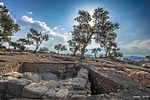Kfar Kedem

Kfar Kedem (Hebrew: כפר קדם) is a tourist center in Israel which reconstructs the everyday life in the Galilee 2000 years ago, during the Mishnah period. Kfar Kedem is located on Route 77, next to the Hamovil intersection. It was established in 1992 in the Hoshaya settlement by Menachem Goldberg. The center includes about 4 acres of vegetation and trees native to the ancient Land of Israel. The site reconstructs Jewish life in the Galilee during the Mishnah period. It is located next to Sepphoris, which was the home base of the Sanhedrin (the highest Jewish religious court), its scholars [rabbis], and their leader, Judah the Prince, one of the compilers of the Mishnah. The site opened in 1992. All visitors start the tour with a short lecture, and immediately afterwards they don Tzitzit, a 4-cornered shawl and a scarf to cover their heads.
Excerpt from the Wikipedia article Kfar Kedem (License: CC BY-SA 3.0, Authors, Images).Kfar Kedem
Emek Izrael Regional Council
Geographical coordinates (GPS) Address Nearby Places Show on map
Geographical coordinates (GPS)
| Latitude | Longitude |
|---|---|
| N 32.756833333333 ° | E 35.299083333333 ° |
Address
Emek Izrael Regional Council
North District, Israel
Open on Google Maps









